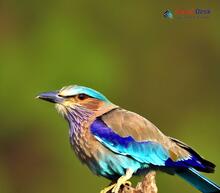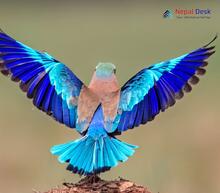The mysterious and alluring world of the Coracias genus has been captivating both casual birdwatchers and avian enthusiasts alike for generations. This charismatic group of birds has a rich evolutionary history and showcases astonishing diversity when it comes to their taxonomy, morphology, and ecology. In this article, we'll dive into the enchanting depths of these captivating creatures and explore their fascinating presence in Nepal.
Evolutionary Tree & Taxonomy
The Coracias genus belongs to the Coraciidae family which consists of around 29 species found across Africa, Europe, Asia, and Australia. Although various studies have attempted to unravel the evolutionary tree of these species, there is still much debate surrounding their exact relationships. Genetic research has provided new insights into the branches of the Coracias family. As a result, the current classification divides the members of this genus into nine distinct species.
Morphology & Adaptations
Birds belonging to the Coracias genus are renowned for their vibrant plumage and striking appearance. They often display sexual dimorphism – with males showcasing more vivid colors than their female counterparts. These astounding creatures possess a relatively robust body structure with short legs and stout bills that are ideally suited for their insectivorous diet.
One interesting morphological feature that sets the Coracias genus apart from others is their ability to perform acrobatic aerial maneuvers – an adaptation that is tailor-made for catching insects mid-flight. These agile airborne hunters utilize impressive speed and precision to snag their prey on the wing.
Ecological Interactions
Coracias species occupy a wide range of habitats – from open woodlands to savannahs and grasslands. Besides being insectivores, some species also consume small vertebrates and fruits on occasion. Consequently, they play a vital role in maintaining balance in their ecosystems as predators of insect populations and, indirectly, as dispersers of fruit seeds.
Moreover, some members of the Coracias genus are known to form symbiotic relationships with other bird species. For instance, the European Roller (Coracias garrulus) is known to nest near raptor species to deter potential nest predators, thus safeguarding their offspring.
Presence in Nepal
In the diverse landscapes of Nepal, we can find two magnificent members of the Coracias genus - the Indian Roller (Coracias benghalensis) and Eurasian Roller (Coracias garrulus). The Indian Roller is a year-round resident found in various habitats ranging from grasslands to agricultural areas across Nepal. On the other hand, the Eurasian Roller is a migrant visitor that passes through Nepal during its migration from Europe and Central Asia to wintering grounds in Africa.
In conclusion, exploring the captivating world of the Coracias genus provides us with a fascinating glimpse into their unique evolutionary history, taxonomy, morphology, and ecological interactions. The presence of these magnificent birds in Nepal adds an extra layer of allure to this exquisite Himalayan nation. As we continue to discover more about these extraordinary avians, our appreciation for their remarkable adaptation and intriguing behavior will only grow further.




